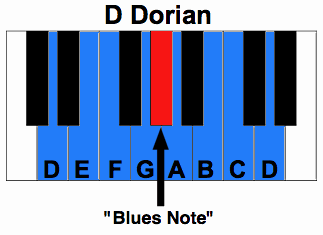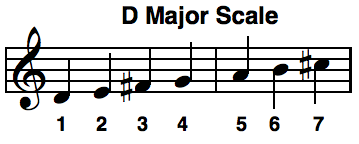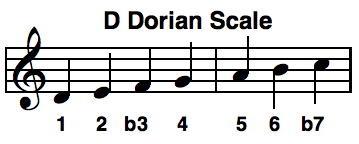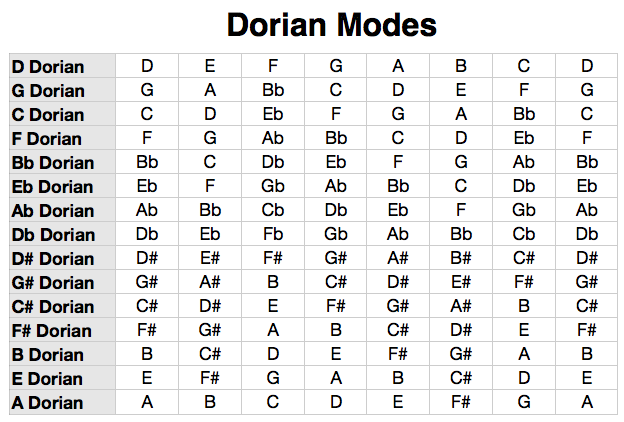The Dorian Scale is the second of seven musical modes. The Dorian Mode is commonly used by Rock musicians. Jazz musicians also use it to get those great Blues sounds.
This mode is the second inversion of themajor scale. Rather than playing this scale like a regular major scale, it is inverted to the second note in the scale rather than the root.
Let’s look at how to build a this mode, and how to easily add it into a piece of music.
What Is The Dorian Mode?
This scale can also be refereed to as the dorian mode. A mode is is a derivative, or alteration, of a major scale.
Instead of playing the major scale in its root position, this scale is played starting on another note.
For example, the D Dorian Mode is the is the second derivative of the C Major Scale.
Rather then playing the C Major Scale starting on C, you will play a the same notes starting and ending on D.
This is the whole premises behind a dorian scale.
We know that the C major scale is made up of the notes C, D, E, F, G, A, B, C.
In order to make D dorian, we need to play those same notes, starting and ending on D.

This would make the notes in the Dorian D scale D, E, F, G, A, B, C, D
Notice that the notes are exactly the same as in the c major scale, they are just start on D instead.
Dorian Mode Patterns
All scales have a set pattern of whole steps and half steps that can be easily followed to make any scale.
The pattern for the dorian scale is a little different from the major scale. This is why this scale sounds so different. The intervals, or distance between notes are different, making the sound of the scale unique.
The pattern for the major scale looks like this:Whole Step – Whole Step – Half Step – Whole Step – Whole Step – Whole Step – Half Step
The pattern for the dorian mode is:Whole Step – Half Step – Whole Step – Whole Step – Whole Step – Half Step – Whole Step
Listen to the difference between the dorian mode and the major scale. You will notice a big difference between the sound of the two scales because of the different intervals they each have..
Major Scale
<<Here In Flash Audio Player>>
Dorian Scale
<<Here In Flash Audio Player>>
Making A Dorian Scale
There are a couple of different ways to build a dorian mode rather then memorizing the pattern of half-steps and whole-steps.
The first one starts with altering the notes in the major scale.
Take a look at the two scales below. You can see where the difference lies between the two scales. The D Major scale has a sharp third and sharp seven. The notes would be D, E, F#, G, A, B, C#
In the D dorian scale, there is a flat third and flat seven. This gives us the notes D, E, F, G, A, B, C. If you notice, these are the same notes that are in the C Major Scale.
 |  |
This is an easy way of finding a dorian scale in any key.
First build the major scale in that key, then flat the third and seventh note.
Quick Tip!
To make a Dorian Scale, build a major scale, and flat the 3rd and 7th!
Another Approach
Another way to find the notes in this scale is to go a whole step down from the dorian mode you are in.
Use D Dorian again as an example. If you want to know the notes in D dorian, just move a whole step, or major second down from D. A whole step down from D is C, this means that the notes in the key of C are the notes in the D dorian mode.
Let’s use G dorian as another example. A whole step down from G is F. This means that the notes in the F Major Scale are the same notes that make up G dorian.
Notes In Each Dorian Scale
Here is a quick chart you can use to find all the notes in each dorian mode quickly and easily.

You can also see the notes on the staff for each of the scales. You can download and print a PDF copy like they are below if you click here.
 |
 |
 |
 |
 |
 |
 |
 |
 |
 |
 |
 |
 |
 |

Isn’t It Just A C Major Scale?
I know your thinking….. “Why does all of this make any difference if I’m still just playing in the key of C Major?
The difference is in where the song resolves, or where the tonal center of the song is. The tonal center for a C major scale is C. In D dorian, the tonal center is going to be D. This means that the entire song is going to revolve around D, rather than C.
This is where people get confused with modes. Instead of thinking of the dorian scale as an alternate C scale, you need to think of it as its own scale in itself. The tonal center of the song is now D, you are just playing the same notes that are in the C major scale.
Make sure that you use D as your new point of influence, and use the notes of the C scale to add flavor to the song.
Let’s Play ‘Em
Now let’s talk about how to incorporate these modes into a song.
The root chord in the dorian mode is a minor7 chord. If you remember from the image above, the dorian mode has a b3 and b7. When we build the root chord for this scale we will use the first, third, fifth, and seventh notes in the scale.
That means, that in d dorian, we will use D, F, A, C to create a Dmin7chord.
With this chord being our new center for the song, we can now use any note in the C scale to improvise or solo.
Using Modes With Chords
Dorian is great because it can be used in a lot of different genres of music.
Pretty much anytime you see a min7 chord, you can use the dorian mode to play over that chord. Use dorian over the chord you are playing to make a great blues sounding solo.
Let’s say that you are playing a song that has a vamp that switches between a Dmin7 chord and an Amin7 chord. You can easily use D dorian and A dorian to create a seamless solo.
Another important thing to remember about dorian is the dominant seven note. The dominant seven note is the cornerstone of the dorian scale.
Its that b7 we were talking about earlier.
This is what gives the scale its flavor. Use it frequently in solos to give the song it’s dorian sound.
Adding The Blues
The best part about the dorian scale is creating a bluesy sound. There is a lot of natural blues in the scale already. The b3 and b7 give it that sound naturally.
But, to really give it a boost of blues, you can add the b5 into the mix.
Quick Tip!
Add the b5 note for an awesome Blues sound!
The flat 5 is the fourth note in the blues scale. It add a a lot of soul into the dorian scale.

Use this note as a grace note by quickly sliding from the b5 to it neighboring note to give a great blues sound.
Moving Forward
Make sure when you are playing in the dorian mode that are careful to use dorian as the root. You may be playing the notes in another key, but dorian becomes the new tonal center for the song.
Keeping the center of the song in its original key and playing dorian won’t do a lot of good. Make sure that you keep the root of dorian the center for the best results.

